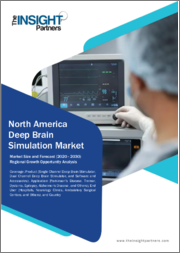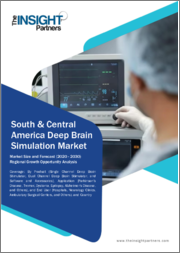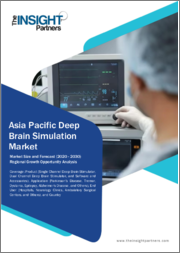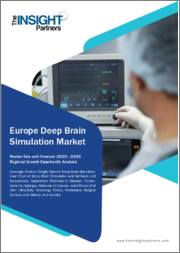
|
시장보고서
상품코드
1402488
북미의 뇌심부 자극치료 시장 예측(-2030년) : 지역별 분석 - 제품, 용도, 최종사용자별North America Deep Brain Simulation Market Forecast to 2030 - Regional Analysis - by Product, Application, and End User |
||||||
북미의 뇌심부 자극치료 시장은 2022년 2억 8,286만 달러에서 2030년에는 5억 4,978만 달러로 성장할 것으로 예측되고 있습니다. 2022-2030년의 CAGR은 8.7%로 추정됩니다.
신경질환의 증가가 북미의 뇌심부 자극치료 시장을 촉진
노인 인구는 신경 질환에 걸리기 쉽습니다. 신경장애, 파킨슨병, 알츠하이머병, 디스토니아는 노인들이 겪는 가장 흔한 신경질환 중 하나입니다. 미국 국립보건원(NIH)에 따르면 전 세계 인구의 8.5%(약 6억 1,700만 명)가 65세 이상입니다. 미국, 캐나다 등의 국가에서는 노인 인구 증가에 따른 운동장애와 정신질환의 유병률이 높습니다. 파킨슨 재단에 따르면 파킨슨 증상은 평균 연령 60세에서 흔히 볼 수 있습니다. 캐나다 심리학회에 따르면 인구의 약 2%가 강박장애(OCD)를 앓고 있습니다. 세계보건기구(WHO)에 따르면 신경질환은 전 세계 질병 부담의 6.3%를 차지하며 전 세계 주요 사망 원인 중 하나입니다. 또한 선진국에서는 사망원인의 13.2%, 중저소득 국가에서는 16.8%가 신경질환으로 보고되고 있습니다. 높은 사망률과 질병 부담으로 인해 뇌심부자극요법(DBS)과 같은 장기적인 해결책을 통합하는 것이 임상적으로 시급합니다. 따라서 신경 질환의 부담에 대한 인식 증가, 노인 인구 증가, 신경 질환의 유병률 증가는 치료로서 뇌심부자극치료에 대한 수요를 촉진하고 있습니다.
북미 뇌심부자극 시장 개요
파킨슨병(PD)과 같은 신경 질환의 유병률 증가, 신경 질환에 대한 인식 증가, 긍정적인 연구 결과, 경두개 자극 장비 개발에 대한 투자 증가는 미국의 전체 뇌심부자극요법 시장의 성장을 가속하는 주요 요인 중 하나입니다. 뇌심부자극(DBS) 장비는 파킨슨병과 관련된 떨림 억제에 효과적인 것으로 확인되었습니다. 도파민 수치 감소 및 기타 유전적 요인은 파킨슨병의 주요 원인 중 하나입니다. 알츠하이머병협회(Alzheimer's Association)가 발표한 '2022 Alzheimer's disease facts and figures'라는 제목의 조사에 따르면 2022년에는 65세 이상 미국인 중 약 650만 명이 알츠하이머병을 앓고 있는 것으로 나타났습니다. 있는 것으로 나타났으며, 이 수치는 2030년까지 1,380만 명으로 증가할 것으로 예측됩니다. 기술 발전과 신제품 출시가 미국 뇌심부자극치료 시장의 성장을 주도하고 있으며, 2020년 1월에는 Abbott의 Infinity DBS 시스템이 미국 식품의약국(FDA)으로부터 파킨슨병 치료제로 승인받았습니다. 이 시스템은 파킨슨병 증상과 관련된 뇌의 특정 부위인 내측 창백구(GPi)를 표적으로 삼아 치료할 수 있습니다. 미국 FDA는 2017년 12월 보스턴 사이언티픽 코퍼레이션(Boston Scientific Corporation)이 사용하는 파킨슨병 치료용 뇌심부자극요법 시스템 'Verses'를 승인했습니다. 파킨슨 재단에 따르면 미국에는 약 100만 명이 파킨슨병을 앓고 있으며, 2030년에는 120만 명으로 늘어날 것으로 예상됩니다. 따라서 신경 질환의 유병률 증가와 기술 발전은 미국의 북미 뇌심부자극요법 시장의 성장을 촉진하고 있습니다.
북미의 뇌심부 자극치료 시장 매출과 2030년까지의 예측(금액)
북미의 뇌심부 자극치료 시장 세분화
북미의 뇌심부 자극치료 시장은 제품, 용도, 최종사용자, 국가로 구분됩니다.
제품별로는 북미의 뇌심부 자극치료 시장은 싱글 채널 뇌심부 자극치료, 듀얼 채널 뇌심부 자극치료, 소프트웨어와 액세서리로 구분됩니다. 2022년에는 듀얼 채널 심부뇌 자극기 부문이 북미뇌심부 자극치료 시장에서 최대 점유율을 기록했습니다.
용도별로는 북미의 뇌심부 자극치료 시장은 파킨슨병, 진전, 근육긴장이상, 간질, 알츠하이머병, 기타로 구분됩니다. 2022년, 파킨슨병 부문은 북미의 뇌심부 자극치료 시장에서 최대 점유율을 기록했습니다.
최종사용자별로는 북미의 뇌심부 자극치료 시장은 병원, 신경과클리닉, 외래 수술 센터, 기타로 구분됩니다. 2022년, 북미의 뇌심부 자극치료 시장에서는 병원 부문이 최대 점유율을 기록했습니다.
국가별로는 북미의 뇌심부 자극치료 시장은 미국, 캐나다, 멕시코로 구분됩니다. 2022년, 미국은 북미의 뇌심부 자극치료 시장에서 최대 점유율을 기록했습니다.
Abbott Laboratories, Boston Scientific Corp, Medtronic Plc, Newronika SpA 등이 북미의 뇌심부 자극치료 시장에서 사업을 운영하고 있는 대기업입니다.
목차
제1장 서론
제2장 주요 요약
- 주요 인사이트
- 북미의 뇌심부 자극치료 시장 : 지역별
제3장 조사 방법
- 조사 범위
- 2차 조사
- 1차 조사
제4장 북미의 뇌심부 자극 시장 구도
- 서론
- 북미 PEST 분석
- 비교 분석
- 뇌심부 자극치료와 병변 형성 시술의 비교
- 신경질환에서 병변 형성 절차
- 2022년에 시행되는 뇌심부 자극 수술 국가별 절차
제5장 북미의 뇌심부 자극치료 시장 : 주요 산업 역학
- 주요 시장 촉진요인
- 신경질환의 유병률 상승
- 저침습수술에 대한 수요의 증가
- 시장 억제요인
- 뇌심부 자극에 수반하는 부작용
- 시장 기회
- 뇌심부 자극치료에서 기술의 진보와 승인
- 향후 동향
- 연구개발의 활발화
- 영향 분석
제6장 뇌심부 자극 시장 : 북미 시장 분석
- 북미의 뇌심부 자극치료 시장 매출, 2022-2030년
제7장 북미의 뇌심부 자극치료 시장 : 제품별 매출과 2030년까지의 예측
- 서론
- 북미의 뇌심부 자극 기기 시장 2022년과 2030년의 제품별 판매고 점유율(%)
- 싱글 채널 뇌심부 자극기
- 듀얼 채널 뇌심부 자극기
- 소프트웨어와 부속품
제8장 북미의 뇌심부 자극치료 시장 : 용도별 매출과 2030년까지의 예측
- 서론
- 북미의 뇌심부 자극치료 시장 : 2022년과 2030년의 용도별 판매고 점유율(%)
- 파킨슨병
- 진전
- 알츠하이머병
- 근육긴장이상
- 간질
- 기타
제9장 북미의 뇌심부 자극치료 시장 : 최종사용자별 매출과 2030년까지의 예측
- 서론
- 북미의 뇌심부 자극치료 시장 : 2022년과 2030년 최종사용자별 판매고 점유율(%)
- 병원
- 신경 클리닉
- 외래 수술 센터
- 기타
제10장 북미의 뇌심부 자극치료 시장 : 국가별 분석
- 개요
- 북미의 뇌심부 자극치료 시장 : 국가별
- 미국
- 캐나다
- 멕시코
제11장 COVID-19 전후의 영향
- COVID-19 전후의 영향
제12장 뇌심부 자극치료 시장 업계 상황
- 서론
- 뇌심부 자극치료 시장의 성장 전략
- 유기적 성장 전략
- 개요
- 무기적 성장 전략
- 개요
제13장 북미의 뇌심부 자극치료 시장 : 주요 기업 개요
- Abbott Laboratories
- Medtronic Plc
- Boston Scientific Corp
- Newronika SpA
제14장 부록
KSA 24.01.16The North America deep brain simulation market is expected to grow from US$ 282.86 million in 2022 to US$ 549.78 million by 2030. It is estimated to grow at a CAGR of 8.7% from 2022 to 2030.
Rising Prevalence of Neurological Disorders Drive North America Deep Brain Simulation Market
The geriatric population is susceptible to neurological diseases. Neuropathy, Parkinson's disease, Alzheimer's disease, and dystonia are among the most common neurological disorders affecting older people. According to the National Institutes of Health (NIH), 8.5% of the world's population (i.e., around 617 million people) are 65 and above. Countries such as the US and Canada have high prevalence rates of movement disorders and psychiatric disorders associated with growing geriatric populations. According to the Parkinson's Foundation, Parkinson's symptoms are common at an average age of 60. The Canadian Psychological Association states that about 2% of the population suffers from obsessive-compulsive disorder (OCD). According to the World Health Organization (WHO), neurological diseases contribute 6.3% to the global disease burden and are one of the leading causes of death across the world. In addition, 13.2% of deaths in developed countries and 16.8% in low- and middle-income countries are reported due to neurological diseases. High mortality and disease burden necessitate the clinical urgency for integrating long-term solutions such as deep brain stimulators (DBS). Therefore, growing awareness regarding the burden of neurological disorders, the growing geriatric population, and the increasing prevalence of neurological diseases propel the demand for deep brain stimulators as a therapy.
North America Deep Brain Simulation Market Overview
The rising prevalence of neurological diseases such as Parkinson's disease (PD), increasing awareness about neurological disorders, positive research results, and growing investments in developing transcranial stimulators are among the main factors driving the overall deep brain stimulation market growth in the US. Deep brain stimulation (DBS) devices have been observed to be effective in controlling the tremors associated with Parkinson's disease. Low dopamine levels and other genetic factors are among the main causes of Parkinson's disease. According to a study titled "2022 Alzheimer's disease facts and figures" published in the Alzheimer's Association, nearly 6.5 million Americans aged 65 and above were found to have Alzheimer's disease in 2022, and that number is projected to rise to 13.8 million by 2060. Technological advancements and new product launches drive the growth of the US deep brain stimulation market. In January 2020, Abbott's Infinity DBS System received US Food and Drug Administration (FDA) approval for treating Parkinson's disease. This system allows for the targeted treatment of a specific area of the brain, called the inner globus pallidus (GPi), which is associated with the symptoms of Parkinson's disease. The US FDA approved the Verses deep brain stimulation device system for treating Parkinson's disease in December 2017 for use by Boston Scientific Corporation. According to the Parkinson's Foundation, around 1 million people in the US are suffering from Parkinson's disease, which is expected to increase to 1.2 million by 2030. Therefore, the increasing prevalence of neurological diseases and technological advancements fuel the North America deep brain simulation market growth in the US.
North America Deep Brain Simulation Market Revenue and Forecast to 2030 (US$ Million)
North America Deep Brain Simulation Market Segmentation
The North America deep brain simulation market is segmented into product, application, end user, and country.
Based on product, the North America deep brain simulation market is segmented into single channel deep brain stimulator, dual channel deep brain stimulator, and software and accessories. In 2022, the dual channel deep brain stimulator segment registered the largest share in the North America deep brain simulation market.
Based on application, the North America deep brain simulation market is segmented into Parkinson's disease, tremor, dystonia, epilepsy, Alzheimer's disease, and others. In 2022, the Parkinson's disease segment registered the largest share in the North America deep brain simulation market.
Based on end user, the North America deep brain simulation market is segmented into hospitals, neurology clinics, ambulatory surgical centers, and others. In 2022, the hospitals segment registered the largest share in the North America deep brain simulation market.
Based on country, the North America deep brain simulation market is segmented into the US, Canada, Mexico. In 2022, the US registered the largest share in the North America deep brain simulation market.
Abbott Laboratories, Boston Scientific Corp, Medtronic Plc, and Newronika SpA are some of the leading companies operating in the North America deep brain simulation market.
Reasons to Buy:
- Save and reduce time carrying out entry-level research by identifying the growth, size, leading players, and segments in the North America deep brain simulation market.
- Highlights key business priorities in order to assist companies to realign their business strategies
- The key findings and recommendations highlight crucial progressive industry trends in the North America deep brain simulation market, thereby allowing players across the value chain to develop effective long-term strategies
- Develop/modify business expansion plans by using substantial growth offering developed and emerging markets
- Scrutinize in-depth North America market trends and outlook coupled with the factors driving the deep brain simulation market, as well as those hindering it
- Enhance the decision-making process by understanding the strategies that underpin commercial interest with respect to client products, segmentation, pricing, and distribution
Table Of Contents
1. Introduction
- 1.1 The Insight Partners Research Report Guidance
- 1.2 Market Segmentation
2. Executive Summary
- 2.1 Key Insights
- 2.2 North America Deep Brain Stimulation Market, by Region (US$ Million)
3. Research Methodology
- 3.1 Coverage
- 3.2 Secondary Research
- 3.3 Primary Research
4. North America Deep Brain Simulation Market Landscape
- 4.1 Overview
- 4.2 North America PEST Analysis
- 4.3 Comparison Analysis
- 4.3.1 Comparison of Deep Brain Stimulation and Lesioning Procedures
- 4.3.2 Lesioning Procedures in Neurological Disorders
- 4.3.3 Deep Brain Stimulation Surgical Procedures Performed in 2022, By Country
5. North America Deep Brain Simulation Market - Key Industry Dynamics
- 5.1 Key Market Drivers:
- 5.1.1 Rising Prevalence of Neurological Disorders
- 5.1.2 Increasing Demand for Minimally Invasive Surgery
- 5.2 Market Restraints
- 5.2.1 Side Effects Associated with Deep Brain Stimulation
- 5.3 Market Opportunities
- 5.3.1 Technological Advancements and Approvals in Deep Brain Stimulation
- 5.4 Future Trends
- 5.4.1 Growing Research and Development Activities
- 5.5 Impact Analysis
6. Deep Brain Simulation Market - North America Market Analysis
- 6.1 North America Deep Brain Simulation Market Revenue (US$ Mn), 2022 - 2030
7. North America Deep Brain Simulation Market - Revenue and Forecast to 2030 - by Product
- 7.1 Overview
- 7.2 North America Deep Brain Simulation Market Revenue Share, by Product 2022 & 2030 (%)
- 7.3 Single Channel Deep Brain Stimulator
- 7.3.1 Overview
- 7.3.2 Single Channel Deep Brain Stimulator: North America Deep Brain Simulation Market - Revenue and Forecast to 2030 (US$ Million)
- 7.4 Dual Channel Deep Brain Stimulator
- 7.4.1 Overview
- 7.4.2 Dual Channel Deep Brain Stimulator: North America Deep Brain Simulation Market - Revenue and Forecast to 2030 (US$ Million)
- 7.5 Software and Accessories
- 7.5.1 Overview
- 7.5.2 Software and Accessories: North America Deep Brain Simulation Market - Revenue and Forecast to 2030 (US$ Million)
8. North America Deep Brain Simulation Market - Revenue and Forecast to 2030 - by Application
- 8.1 Overview
- 8.2 North America Deep Brain Simulation Market Revenue Share, by Application 2022 & 2030 (%)
- 8.3 Parkinson's Disease
- 8.3.1 Overview
- 8.3.2 Parkinson's Disease: North America Deep Brain Simulation Market - Revenue and Forecast to 2030 (US$ Million)
- 8.4 Tremor
- 8.4.1 Overview
- 8.4.2 Tremor: North America Deep Brain Simulation Market - Revenue and Forecast to 2030 (US$ Million)
- 8.5 Alzheimer's Disease
- 8.5.1 Overview
- 8.5.2 Alzheimer's Disease: North America Deep Brain Simulation Market - Revenue and Forecast to 2030 (US$ Million)
- 8.6 Dystonia
- 8.6.1 Overview
- 8.6.2 Dystonia: North America Deep Brain Simulation Market - Revenue and Forecast to 2030 (US$ Million)
- 8.7 Epilepsy
- 8.7.1 Overview
- 8.7.2 Epilepsy: North America Deep Brain Simulation Market - Revenue and Forecast to 2030 (US$ Million)
- 8.8 Others
- 8.8.1 Overview
- 8.8.2 Others: North America Deep Brain Simulation Market - Revenue and Forecast to 2030 (US$ Million)
9. North America Deep Brain Simulation Market - Revenue and Forecast to 2030 - by End User
- 9.1 Overview
- 9.2 North America Deep Brain Simulation Market Revenue Share, by End User 2022 & 2030 (%)
- 9.3 Hospitals
- 9.3.1 Overview
- 9.3.2 Hospitals: North America Deep Brain Simulation Market - Revenue and Forecast to 2030 (US$ Million)
- 9.4 Neurology Clinics
- 9.4.1 Overview
- 9.4.2 Neurology Clinics: North America Deep Brain Simulation Market - Revenue and Forecast to 2030 (US$ Million)
- 9.5 Ambulatory Surgical Centers
- 9.5.1 Overview
- 9.5.2 Ambulatory Surgical Centers: North America Deep Brain Simulation Market - Revenue and Forecast to 2030 (US$ Million)
- 9.6 Others
- 9.6.1 Overview
- 9.6.2 Others: North America Deep Brain Simulation Market - Revenue and Forecast to 2030 (US$ Million)
10. North America Deep Brain Simulation Market - Country Analysis
- 10.1 Overview
- 10.1.1.1 North America Deep Brain Simulation Market, by Country
- 10.1.1.2 US
- 10.1.1.2.1 Overview
- 10.1.1.2.2 US Deep Brain Simulation Market Revenue and Forecast to 2030 (US$ Mn)
- 10.1.1.2.3 US Deep Brain Simulation Market, by Product
- 10.1.1.2.4 US Deep Brain Simulation Market, by Application
- 10.1.1.2.5 US Deep Brain Simulation Market, by End User
- 10.1.1.3 Canada
- 10.1.1.3.1 Overview
- 10.1.1.3.2 Canada Deep Brain Simulation Market Revenue and Forecast to 2030 (US$ Mn)
- 10.1.1.3.3 Canada Deep Brain Simulation Market, by Product
- 10.1.1.3.4 Canada Deep Brain Simulation Market, by Application
- 10.1.1.3.5 Canada Deep Brain Simulation Market, by End User
- 10.1.1.4 Mexico
- 10.1.1.4.1 Overview
- 10.1.1.4.2 Mexico Deep Brain Simulation Market Revenue and Forecast to 2030 (US$ Mn)
- 10.1.1.4.3 Mexico Deep Brain Simulation Market, by Product
- 10.1.1.4.4 Mexico Deep Brain Simulation Market, by Application
- 10.1.1.4.5 Mexico Deep Brain Simulation Market, by End User
11. Pre & Post Covid-19 Impact
- 11.1 Pre & Post Covid-19 Impact
12. Deep Brain Simulation Market Industry Landscape
- 12.1 Overview
- 12.2 Growth Strategies in Deep Brain Stimulation Market
- 12.3 Organic Growth Strategies
- 12.3.1 Overview
- 12.4 Inorganic Growth Strategies
- 12.4.1 Overview
13. North America Deep Brain Simulation Market, Key Company Profiles
- 13.1 Abbott Laboratories
- 13.1.1 Key Facts
- 13.1.2 Business Description
- 13.1.3 Products and Services
- 13.1.4 Financial Overview
- 13.1.5 SWOT Analysis
- 13.1.6 Key Developments
- 13.2 Medtronic Plc
- 13.2.1 Key Facts
- 13.2.2 Business Description
- 13.2.3 Products and Services
- 13.2.4 Financial Overview
- 13.2.5 SWOT Analysis
- 13.2.6 Key Developments
- 13.3 Boston Scientific Corp
- 13.3.1 Key Facts
- 13.3.2 Business Description
- 13.3.3 Products and Services
- 13.3.4 Financial Overview
- 13.3.5 SWOT Analysis
- 13.3.6 Key Developments
- 13.4 Newronika SpA
- 13.4.1 Key Facts
- 13.4.2 Business Description
- 13.4.3 Products and Services
- 13.4.4 Financial Overview
- 13.4.5 SWOT Analysis
- 13.4.6 Key Developments
14. Appendix
- 14.1 About Us
- 14.2 Glossary of Terms












